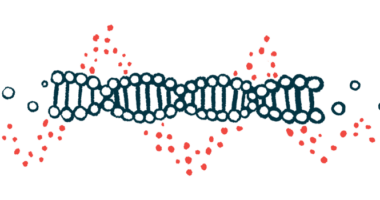Substrate-reducing ASOs show promise in Pompe mouse model
Study finds therapy reduces glycogen accumulation in skeletal muscles

A new type of substrate reduction therapy composed of antisense oligonucleotides, or ASOs, effectively reduces glycogen accumulation in the skeletal muscles, or those attached to bones, of a Pompe disease mouse model, a study found.
When combined with standard enzyme replacement therapy (ERT), which showed limited efficacy in skeletal muscles, motor performance improved further than with the ASO alone.
“These findings highlight the potential of combining [ASO] with ERT as a promising therapeutic strategy for Pompe disease, overcoming tissue-specific limitations and supporting overall cellular function,” the researchers wrote.
The study, “Skeletal muscle effects of antisense oligonucleotides targeting glycogen synthase 1 in a mouse model of Pompe disease,” was published in Clinical and Translational Medicine.
In Pompe, the dysfunction of the GAA enzyme leads to the toxic buildup of glycogen, a complex sugar molecule, primarily in muscle cells, which gives rise to progressive muscle weakness. If left untreated, glycogen accumulation in the heart and skeletal muscle can increase the risk of heart and respiratory failure.
Targeting glycogen-producing enzyme
ERT is the standard type of treatment for Pompe disease, which involves administering a lab-made, working version of the GAA enzyme to break down glycogen. While ERT works well in lessening the heart manifestations of Pompe, it loses sustained benefit in improving skeletal muscle function.
Substrate reduction therapies are being developed to lower glycogen levels by targeting glycogen synthase (GYS1), the enzyme responsible for glycogen production in muscle cells. However, GYS1 is nearly identical to GYS2, another version of the enzyme found exclusively in the liver, where it’s involved in maintaining proper body glucose (sugar) balance.
“Finding specific inhibitors for GYS1 is challenging given the presence of the highly [similar] GYS2 in the liver,” the researchers wrote.
Antisense oligonucleotides, or ASOs, are short, lab-made stretches of DNA or RNA that bind to and interfere with specific RNA molecules, ultimately affecting protein production.
A team led by researchers at the University of California, Irvine, alongside scientists at Ionis Pharmaceuticals, designed ASOs that specifically target and suppress the production of GYS1 but not GYS2.
The team tested the ASOs in a Pompe mouse model, which was bred to lack the GAA enzyme and showed progressive glycogen accumulation and muscle weakness.
To model the infantile-onset form of the disease, young Pompe mice were treated with the most potent ASO, which led to a dose-dependent reduction in Gys1 messenger RNA (mRNA), the intermediate molecule that serves as a template for GAA enzyme production, in skeletal muscle. In line with these results, the GYS1 protein and glycogen levels were also reduced in these muscles. An analysis of muscle tissue under the microscope showed consistent findings.
Overall, the impact of ASO treatment was more pronounced in the thigh and the diaphragm (a major muscle involved in breathing), with more variability in the reduction of GYS1 protein levels in the heart.
Older Pompe mice received ASO treatment to model late-onset Pompe disease, when the disease had already progressed. As in younger mice, treatment reduced Gys1 mRNA and GYS1 protein in thigh, diaphragm, and heart muscles. Still, a low amount of glycogen remained in the skeletal muscle of these older mice.
“This may be attributed to compensatory mechanisms, or the presence of very low levels of residual GYS1 enzymatic activity,” the team wrote.
ASO treatment failed to slow the deterioration of motor function in older Pompe mice, as assessed by the rotarod test, in which mice are placed on a revolving rod, and the time it takes them to fall is recorded. The researchers noted minor motor improvements in five of the 10 ASO-treated animals, compared with one or none of the control mice.
Testing ASO and ERT in mouse model
The team then combined the ASO treatment with alglucosidase alfa, an ERT sold as Lumizyme in the U.S., to both reduce glycogen production and remove preexisting glycogen in the muscles of older Pompe mice.
ASO plus ERT led to a steady increase in rotarod performance over the four-month treatment period. In contrast, the ASO alone increased rotarod performance during the first three months, and also at four months but to a lesser extent than with the combination. However, ERT alone could not prevent the functional decline in aging Pompe mice.
Tissue analysis revealed that the ASO reduced glycogen in the diaphragm, but adding ERT significantly boosted its effect. ERT alone had some minor impact on glycogen accumulation in thigh and diaphragm muscle, but it was more efficacious in the heart. Further examination suggested that the ASO may enhance muscle regeneration with or without ERT.
ASO treatment with or without ERT, but not ERT alone, also improved markers of autophagy, a process by which cells break down and eliminate unwanted proteins and other substances, which is impaired in Pompe.
Pompe-related abnormalities in the spinal cord of these mice were not affected by ASO treatment, indicating that it could not, in its current form, cross the blood-brain barrier. This membrane prevents potentially harmful substances in the bloodstream from reaching the brain and spinal cord.
“Our results provide a strong foundation for validation of the use of Gys1 ASO, alone or in combination with ERT, as a therapy for [Pompe disease],” the researchers wrote. “We propose that early administration of Gys1 ASO in combination with ERT may be the key to preventative treatment options in [Pompe disease].”








